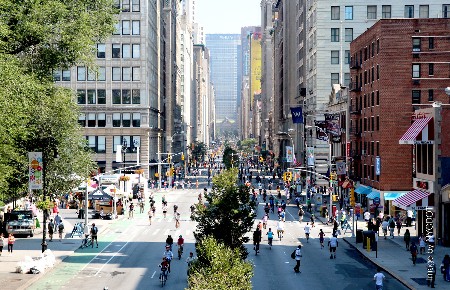Dr. Georges Aoude is CEO and Co-Founder of Derq, a spinoff from the Massachusetts Institute of Technology. Derq is focused on the future of connected and autonomous roads, making city roads smarter and safer, and deploying autonomous vehicles wherever possible. The company has patented a smart infrastructure platform powered by artificial intelligence that leverages existing traffic cameras and sensors to help tackle the most challenging road safety and traffic management problems. Derq is also in the business of supplying cities with autonomous vehicle fleets. Georges in this posting provides a vision of what is possible to make Vision Zero a reality.
Vision Zero is a newer strategy for eliminating deaths and severe injuries from road traffic and other unsafe urban infrastructure. First implemented in parts of Europe, the strategy has successfully gained traction in North American cities.
Most drivers today are conditioned to think fatalities on the road are inevitable, but the reality is that there are now resources to prevent such accidents. The key to a preventive approach is to prioritize traffic safety as a public health issue.
In 2020, more than 40,000 people in the United States were killed in crashes. This significant loss of life exacts a tragic toll. Pedestrian deaths in 2020 increased 21% from 2019 even with fewer vehicles on the road because of the pandemic and economic downturn. Not only was there personal loss, but also deep community impacts including economic and healthcare costs as well as emotional trauma for the victims and their families.
Vision Zero: A Commitment to Change
Vision Zero is a different approach to traffic safety. It begins with a premise that all of society deserves the right to experience safe use of roadways. It also makes it the shared responsibility of policymakers, system designers and technology experts to implement safe road infrastructure. This is far different from the traditional approach to traffic which makes the responsibility that of the individual whether driver or pedestrian.
For policymakers and planners, committing to Vision Zero means unlearning old ways of designing roads and transportation infrastructure. It means focusing on roadway environment improvements to dramatically lessen the number and severity of crashes.
What are the technologies involved in Vision Zero? They include video analytics using artificial intelligence (AI) and machine learning to analyze massive amounts of video data of complex traffic situations. These companies include Waycare, Derq and Applied Information, developers of software designed to:
- analyzing behavioural patterns of vehicles
- analyze pedestrian behaviour
- study traffic flows in real-time
- identify and anticipate road incidents.
These advanced video analytics can trigger pedestrian signage to blink and alert a driver who may not see someone crossing a road. The software also can alert city operators to send emergency responders to locations when collisions are detected.
Real-time AI analytics also can provide additional context including incident identification, near-miss heatmaps and accurate traffic counts to share with traffic engineers and operators, to allow them to better understand traffic patterns and proactively improve road safety.
Is Vision Zero Built into the Current U.S. Infrastructure Plan?
President Biden’s administration recently released a proposal to spend an estimated $1 trillion US on infrastructure projects. The proposed legislation includes a large piece devoted to innovation for smart infrastructure. The Vision Zero strategy is designed to go hand-in-hand with what the legislation proposes.
Biden’s infrastructure plan has set aside:
- $312 billion for surface transportation projects
- $109 billion dedicated to improving roads, bridges and other vital transportation projects.
- $20 billion to be given to states and local governments for a Safe Streets for All program improving roadway user safety with a specific emphasis on cyclists and pedestrian safety.
Advocacy groups have been calling for such a plan which through implementing the technologies envisioned in Vision Zero, can become a reality.









